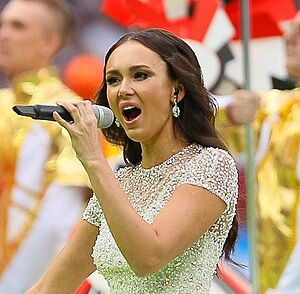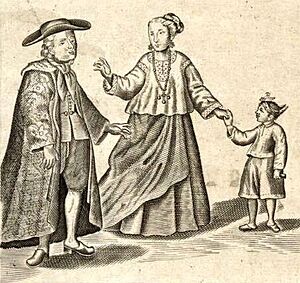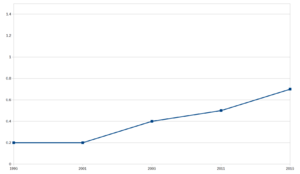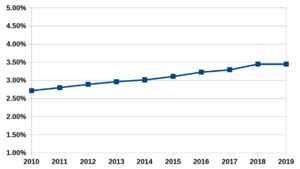Mixed race facts for kids
          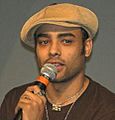 
|
|
| Total population | |
|---|---|
| Official population numbers are unknown. | |
| Regions with significant populations | |
| Worldwide |
A mixed-race or multiracial person is someone who has family members, like parents or grandparents, from different racial backgrounds. This means their family history includes a mix of different groups of people. Being multiracial is a common experience around the world.
Mixed Heritage Around the World
Latin America's Diverse People
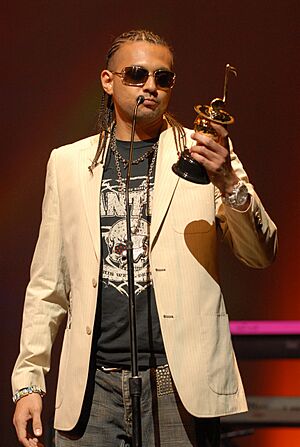
In Latin America, a common word for multiracial people is Mestizo. This term often describes people with both Amerindian and Spanish ancestors. Mestizos make up a large part of the population in many Latin American countries. In some, they are even the majority.
From the time of the Spanish colonies, mixing of different racial groups was recognized. There were even official names for different mixes. Over time, these old systems changed. Many countries became independent from Spain and removed these official classifications. However, some terms are still used today.
Racial mixing has been important in the history and politics of many Latin American nations. In countries like Mexico, Dominican Republic, and Colombia, most people have a biracial or multiracial background.
Some leaders and thinkers have celebrated this mixed heritage. For example, the Mexican philosopher José Vasconcelos wrote about a "Cosmic Race." This idea celebrated the mixing of different cultures and races. Venezuelan president Hugo Chávez, who had Spanish, Indigenous, and African ancestors, also spoke positively about the mixed heritage of Latin Americans.
Brazil's Rich Mix of Cultures
In Brazil, many people identify as pardo, which means multiracial. The 2000 census showed that about 38.5% of Brazilians identified this way. While pardo is an official term, people often use moreno (light-moreno or dark-moreno) to describe their skin color. These terms are not seen as offensive.
The most common mixed groups in Brazil are:
- Mulato: People with African and European heritage.
- Caboclo or mameluco: People with Amerindian and European heritage.
- Cafuzo: People with African and Amerindian heritage.
- Ainocô: People with East Asian (often Japanese) and European heritage.
Many multiracial Brazilians have a mix of three origins: Amerindian, European, and African. Because mixing has happened for many generations, it can be hard for some people to trace their exact family history. There is a lot of integration between different groups in Brazil. However, there can still be social and economic differences. People with more European ancestors are often in upper and middle classes. Those with African, Amerindian, or mixed ancestors are more often in middle and lower classes.
South Africa's Diverse Population
In South Africa, there was once a law called the Prohibition of Mixed Marriages Act. This law made it illegal for white people to marry non-white people. Non-white people were classified as Black, Asian, or Coloured.
Multiracial South Africans are often called Coloureds. In the 2001 South African Census, they were the second largest minority group. They made up 8.9% of the population.
Singapore's Mixed Groups
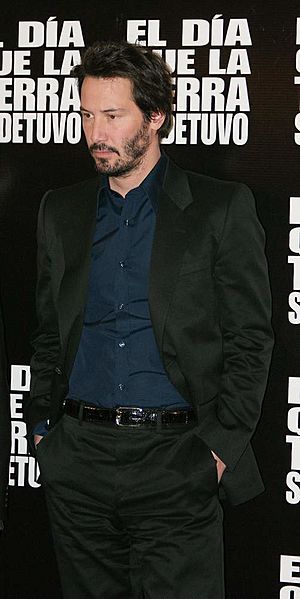
According to government numbers from September 2007, Singapore had 4.68 million people. Of these, Eurasians (people with European and Asian heritage) and other mixed groups made up 2.4% of the population.
The Philippines' Rich History of Mixing
The Philippines has a long history of different groups mixing. The first people to settle there were Australoid groups called Negritos. Later, they mixed with the main Malayo-Polynesian population.
In ancient times, the Philippines was known for its wealth. It attracted many travelers, traders, and adventurers from all over the world. The Greeks called it "Chryse," meaning "Golden One." Indians called it "Suvarnadvipa," the "Island of Gold." The Chinese also traded there a lot.
There has been Indian influence in the Philippines for a long time. About 25% of words in the Tagalog language come from Sanskrit. Also, about 5% of the country's population has some Indian ancestry from ancient times.
Chinese people have been in the Philippines since the ninth century. However, many more Chinese people moved there during the Spanish colonial era. It is thought that 10% to 20% of Filipinos have some Chinese ancestry.
Major Arab migration happened when Islam spread in the Philippines. Some Filipino-Muslim royal families say they are descended from Arab ancestors.
The Philippines also saw migration from Mexico and other Spanish colonies in Latin America. This happened during the Spanish colonial era. The Galleon trade connected the cultures of Mexico, the Philippines, and Spain. This connection can still be seen in the many Aztec and Spanish words used in Philippine Languages.
During the American colonial era, more mixing occurred. This led to the rise of Amerasians. These are people with Asian and American ancestry. They might also have roots from African-Americans, Latino-Americans, or Native Americans.
A recent study by Stanford University found that at least 3.6% of the population has some European ancestry. This comes from both Spanish and United States colonization.
These historical events created a special social group of mixed-race Filipinos called mestizos. These people often hold high positions in society. They are involved in arts, sciences, politics, media, business, and industry.
In the Spanish era, "Mestizo" first meant people with mixed indigenous Austronesian and Spanish ancestry. But the term soon became a general word for "mixed race." It referred to all Filipinos with mixed indigenous Malayo-Polynesian and other ancestries.
Today, Filipino mestizos can have Chinese, American, European, Mexican, Arab, African, Indian, and Mesoamerican ancestors. This is due to the many migrations and colonizations in the Philippines' history. It is also a result of the global Philippine Diaspora.
Currently, there are no official numbers on how many mestizos live in the Philippines. This is because government censuses do not usually record racial backgrounds.
United Kingdom's Mixed Population

In 2000, The Sunday Times reported that Britain had a high rate of interracial relationships. The 2001 census showed that 1.4% of the population in England identified as mixed-race.
In Britain, many multiracial people have Caribbean, African, or Asian heritage. Some, like Formula One driver Lewis Hamilton, describe themselves as 'black'. Most mixed-race Britons identified as 'mixed race' in the 2001 census.
The 2001 UK Census included a section called Mixed. About 1.4% of people chose this option. This was further divided into:
- White and Black Caribbean
- White and Asian (South Asia)
- White and Black African
- Other Mixed
By 2005, estimates showed that 1.6% of the population was mixed-race. Also, 2005 birth records showed that at least 3.5% of new babies were mixed-race.
Cities and Regions with Many Mixed-Race People
- West Midlands - 2.14%
- Nottingham - 3.70%
- Manchester - 3.23%
- London - 3.15%
- Lambeth - 4.83%
- Slough - 3.00%
- Birmingham - 2.90%
- Wolverhampton - 2.70%
- Luton - 2.56%
- Leicester - 2.30%
- Coventry - 2.20%
- Liverpool - 2.20%
- Bristol - 2.08%
- Derby - 2.00%
- Gloucester - 2.00%
- Cardiff - 1.99%
- Leeds - 1.80%
- Sheffield - 1.60%
- Southampton - 1.50%
- City of Bradford - 1.40%
Canada's Growing Mixed Population
In 2006, multiracial Canadians made up 1.5% of the population. This was an increase from 1.2% in 2001. The mixed-race population grew by 25% between these censuses.
The most common mixed backgrounds were:
- Multiple visible minorities: For example, people with both Black and South Asian heritage.
- White-Black
- White-Latin American
- White-Chinese
There are also many other smaller combinations.
Another 1.2% of Canadians are Métis. These are descendants of a historical group with both Aboriginal and European ancestors. Their European heritage often includes French, Scottish, and Irish groups.
This brings the total mixed population in Canada to about 3%. This percentage is higher than in the United Kingdom and the United States.
United States' Changing Demographics
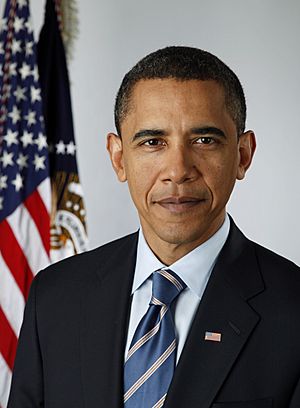
In 2006, about 6.1 million US Americans identified as multiracial. This was 2.0% of the population. They can be any mix of races, such as White, Black or African American, Asian, American Indian or Alaska Native, Native Hawaiian or other Pacific Islander, or "Some other race."
The U.S. has a growing movement for multiracial identity. In the past, interracial marriage was often seen as wrong and was illegal in many states. This was especially true for marriages between white and Black people. Laws also stopped White-Asian American marriages in some western states until the 1950s.
As society and laws have changed, interracial marriages are now accepted. Their mixed-race children are slowly changing the look of America's population. However, experts say that Americans have always been a mix of different ethnic groups. These groups came from various immigrant nationalities. They became more similar through assimilation and integration in the mid-20th century. So, the diversity of millions of Americans is not a new thing.
Types of Mixed-Race People
|
African-origin
American-origin
|
Asian-origin
European-origin
Other types
|
Images for kids
-
Extended Coloured family from South Africa.


